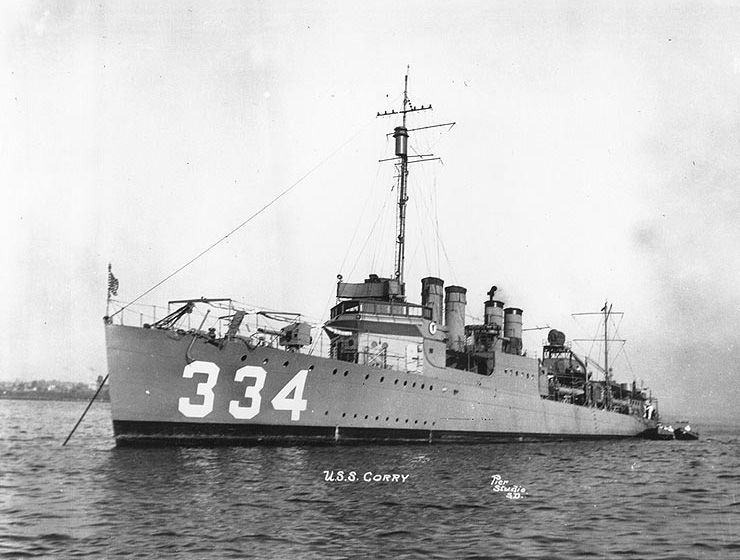 |
| Hulk of the Clemson-class destroyer Corry. |
When the United States entered World War One, a crash program to construct destroyers was implemented, to combat Imperial Germany's large submarine fleet. The navy was also developing a fleet of extremely fast ships that consisted of the Lexington-class battlecruisers and the Omaha-class scout cruisers. This new series of destroyers would serve as high-speed scouts, which gave the ships sleek lines and extremely high speed.
 |
| Destroyer Corry in the early 1920s. |
Ultimately, three versions of the 'Four-stackers' were built: the Caldwell-class, Wickes-class, and Clemson-class. During and after World War One, a total of 273 ships of the three classes would be completed. But Imperial Germany's collapse in November 1918 caught the shipyards by surprise and the United States was stuck with a huge fleet of destroyers with no war to fight. Also, the changed post-war world meant the Lexington-class battlecruisers were no longer needed, so the vision of a fleet built around high speed ships would not come to fruition. Post-war downsizing and treaty obligations meant most of the ships went into mothballs, referred to at the time as 'Red Lead Row".
The navy implemented a unique process for using the large supply of surplus Four-stack destroyers. Some ships would be kept in service until they were due for a major refit. Those ships would then be decommissioned and scrapped, and replaced with a new and relatively unused destroyer from Red Lead Row.
 |
| Stern of destroyer Corry during scrapping. |
USS Corry (DD-334) was a Clemson-class destroyer, constructed at Bethlehem Shipbuilding Corporation in San Francisco, California. She was commissioned on 25 May 1921 and was one of the ships kept in service immediately after the war. She spent her entire career along the US west coast and served as an escort for President Warren Harding during his visit to Alaska in 1923. In late 1929 Corry was prepared for decommissioning, to be replaced by a newer Four-stacker from the reserve fleet. Corry went to Mare Island Naval Shipyard where she underwent scrapping starting in 1930.
 |
| Stern of the destroyer Corry. Compare with the same view while she is being scrapped. |
For some reason, scrapping was halted after most of Corry's superstructure and parts of her forward hull were removed. Her hulk was then towed to the Napa River and abandoned. Over the years the remaining sections of her superstructure were either removed or deteriorated, and her hulk rusted away. But the ship's hull is still largely intact and is likely the most complete example of a Four-stacker that is above water.
NOTE: Just as I finished writing this up, I found out there is the wreck of a second Four-stack destroyer in the southern end of San Francisco Bay. Referred to as the 'South Bay Wreck' by locals, it is the remains of the USS Thompson (DD-305). As with Corry, Thompson remained in commission after World War One, then was sold for scrapping in the early 1930s. However, Thompson was purchased for use as a floating restaurant until she was sold back to the US Navy during World War Two. She was then used as an aerial target. Her wreck can still be visited today, although she is nearly indistinguishable as a Four-stacker destroyer.
 |
| Remains of USS Thompson (DD-305) aka the 'South Bay Wreck'. |







